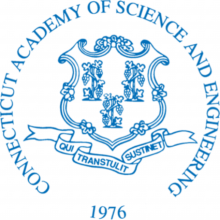Hartford, CT — The Connecticut Academy of Science and Engineering announces the election of twenty-eight of Connecticut’s leading experts in science, engineering and technology to membership in the Academy. The newly elected members will be introduced tonight at the Academy’s 35th Annual Meeting and Dinner, with a reception at the Connecticut Science Center, followed by dinner at the Marriott Hartford Downtown Hotel.
The twenty-eight newly elected members are:
- Emmanouil N. Anagnostou, PhD, Northeast Utilities Foundation Chair in Environmental Engineering and Professor of Civil & Environmental Engineering, School of Engineering, University of Connecticut
- Michael J. Caplan, MD, PhD, C.N.H. Long Professor, Department of Cellular and Molecular Physiology, Yale School of Medicine
- Michael Cappello, MD, Professor of Pediatrics, Microbial Pathogenesis, and Public Health; Director, Yale World Fellows Program, Yale School of Medicine
- Richard E. Carson, PhD, Professor of Diagnostic Radiology and Biomedical Engineering; Yale School of Medicine
- C. Barry Carter, PhD, Professor and Head, Chemical, Materials and Biomolecular Engineering, School of Engineering, University of Connecticut
- Sir Peter Crane, PhD, Carl W. Knobloch Jr. Dean, School of Forestry & Environmental Studies; Professor of Botany, Yale University
- Elizabeth A. Eipper, PhD, Janice and Rodney Reynolds Professor of Neurobiology; University of Connecticut Health Center
- Durland Fish, PhD, Professor, Division of Epidemiology of Microbial Diseases, School of Public Health, with Joint Appointment in the School of Forestry & Environmental Studies, Yale University
- Robert X. Gao, PhD, Pratt & Whitney Chair Professor, Department of Mechanical Engineering, School of Engineering, University of Connecticut
- David A. Hafler, MD, Gilbert H. Glaser Professor; Chairman, Department of Neurology, Yale School of Medicine
- Victor M. Hesselbrock, PhD, Professor and Vice Chair, Department of Psychiatry, University of Connecticut Health Center
- Kent E. Holsinger, PhD, Professor, Department of Ecology and Evolutionary Biology, University of Connecticut
- Karl L. Insogna, MD, Professor of Internal Medicine; Director, Yale Bone Center, Yale School of Medicine
- Robert E. LaBarre, PhD, Principal Mathematician & Group Leader, United Technologies Research Center
- Senjie Lin, PhD, Professor of Marine Sciences, University of Connecticut
- David D. Liu, PhD, Advisory Engineer, Northrop Grumman Corporation
- Richard E. Mains, PhD, Professor and Chair, Neuroscience Department, University of Connecticut Health Center
- Susan T. Mayne, PhD, Professor and Head, Division of Chronic Disease Epidemiology, School of Public Health, Yale University
- Carolyn M. Mazure, PhD, Professor of Psychiatry and Psychology; Associate Dean for Scientific Affairs; Director, Women’s Health Research at Yale, Yale School of Medicine
- James O’Donnell, PhD, Professor of Marine Sciences and Joint Professor of Physics, University of Connecticut
- David E. Parekh, PhD, Vice President of Research, United Technologies Corporation; Director, United Technologies Research Center
- Lisa D. Pfefferle, PhD, C. Baldwin Sawyer Professor, Department of Chemical Engineering, School of Engineering and Applied Science, Yale University
- Zbigniew “Jerry” Piech, PhD, Otis Fellow, Engineering Center, Otis Elevator Company
- G. Shirleen Roeder, PhD, Eugene Higgins Professor of Molecular, Cellular & Developmental Biology and Genetics, Yale School of Medicine; and Investigator Howard Hughes Medical Institute
- Joseph J. Sangiovanni, PhD, Senior Fellow, United Technologies Research Center
- Robert J. Schoelkopf, PhD, William A. Norton Professor of Applied Physics and Physics, Yale University
- Peter Setlow, PhD, Professor of Molecular, Microbial and Structural Biology, University of Connecticut Health Center
- Shengli Zhou, PhD, United Technologies Corporation Professor in Engineering Innovation, Department of Electrical and Computer Engineering, School of Engineering, University of Connecticut
Election to the Academy is on the basis of scientific and engineering distinction achieved through significant contributions in theory or applications, as demonstrated by original published books and papers, patents, the pioneering of new and developing fields and innovative products, outstanding leadership of nationally recognized technical teams, and external professional awards in recognition of scientific and engineering excellence. The Academy’s membership is limited to 400 individuals.
###

